Autism and Schizophrenia

Understanding Autism and Schizophrenia: A Neurodevelopmental Perspective
Autism spectrum disorder (ASD) and schizophrenia are distinct neurodevelopmental conditions with unique clinical profiles. Yet, emerging research reveals significant overlaps at genetic, neurobiological, and behavioral levels. This article delves into their similarities and differences, exploring how these disorders interconnect and what recent scientific advances uncover about their shared mechanisms.
Overview of Autism Spectrum Disorder and Schizophrenia
What are the similarities and differences between autism spectrum disorder and schizophrenia?
Both autism spectrum disorder (ASD) and schizophrenia are neurodevelopmental disorders that can impair social interactions and cognition. They share features such as social withdrawal, communication difficulties, and some behavioral overlaps. However, their onset ages, symptoms, and development trajectories differ.
ASD is usually diagnosed in early childhood, characterized by persistent deficits in social communication, restricted interests, and repetitive behaviors. Its course is generally stable over time. In contrast, schizophrenia typically begins in late adolescence or early adulthood, presenting with hallucinations, delusions, disorganized thinking, and negative symptoms like social withdrawal and flat affect. While both conditions can involve social impairments, schizophrenia often involves psychosis and a more declining functional course.
Recent research highlights overlaps at biological and genetic levels, but their clinical features and underlying neurobiological mechanisms maintain distinct profiles. ASD tends to involve early developmental issues with a stable course, whereas schizophrenia involves a later onset with episodic psychotic episodes.
Definition and core features of ASD
Autism spectrum disorder (ASD) is a lifelong neurodevelopmental condition diagnosed primarily in early childhood. Its core features include:
- Restricted or repetitive behaviors
- Difficulties with social communication and interaction
- A stable developmental course
- Sensory sensitivities and challenges with sensory processing ASD does not typically involve psychosis but is characterized by differences in how individuals process social and sensory information.
Definition and core features of schizophrenia
Schizophrenia is a severe mental health disorder usually diagnosed in late adolescence or early adulthood. It is characterized by:
- Hallucinations, especially auditory
- Delusions
- Disorganized speech and behavior
- Negative symptoms like social withdrawal and emotional flattening
- Cognitive impairments, particularly in memory and reasoning Schizophrenia involves a significant loss of contact with reality and can fluctuate in severity.
Typical age of onset and natural history
ASD generally presents early, with symptoms observable by age 2 or 3, and remains relatively stable over a person’s lifetime. Early diagnosis allows for intervention that can improve social and communication skills. Schizophrenia usually manifests in late adolescence or early adulthood, often after a prodromal phase marked by social withdrawal and subtle cognitive issues. Its course can be episodic or chronic, with symptoms sometimes fluctuating despite medication and therapy.
Understanding these differences while recognizing overlapping features can aid clinicians in accurate diagnosis and effective treatment planning.
Differentiating Clinical Features and Diagnostic Challenges
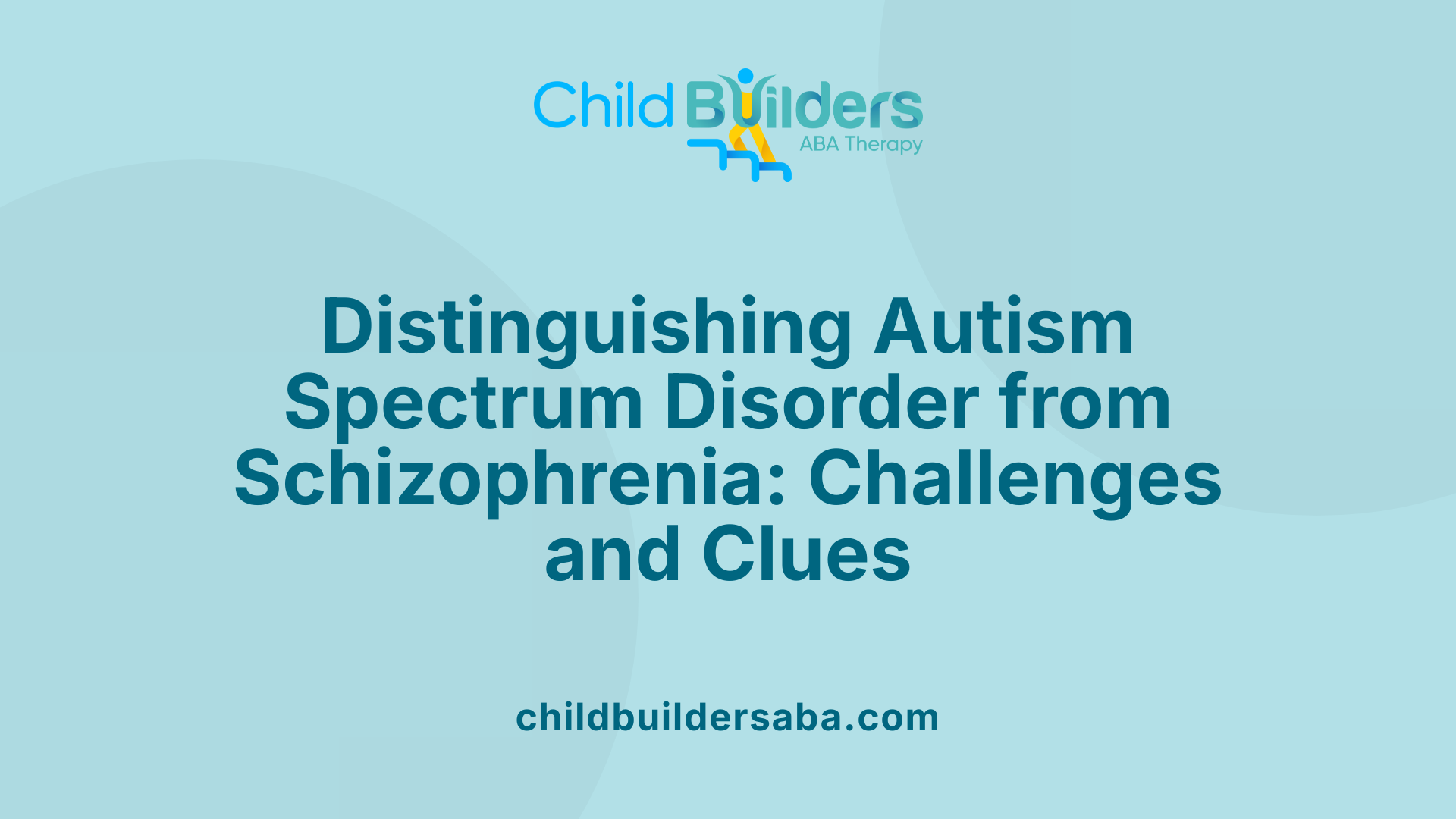
What are the challenges in diagnosing and differentiating autism spectrum disorder from schizophrenia?
Distinguishing autism spectrum disorder (ASD) from schizophrenia can be quite complex due to overlapping features. Both conditions involve difficulties with social communication, social withdrawal, and unusual behaviors, which may lead to diagnostic confusion.
One of the primary challenges is that some autistic individuals, especially those with high-functioning autism, can exhibit psychotic-like symptoms such as hallucinations or delusional thinking. These features are typically associated with schizophrenia but can sometimes appear in ASD, particularly when communication barriers prevent clear assessment.
The age of onset and the course of symptoms also differ between the two disorders. ASD symptoms usually emerge early in childhood, around 12 to 24 months, and tend to remain stable over time. In contrast, schizophrenia often develops later, during late adolescence or early adulthood, with a pattern of episodic psychotic episodes and progression.
Furthermore, standard neuropsychological tests and behavioral assessments can sometimes produce similar profiles, making differentiation difficult without a detailed developmental history and careful clinical judgment.
To improve diagnostic accuracy, clinicians rely on a combination of tools and approaches. This includes in-depth interviews, observation of social and communicative behaviors, and specialized assessment instruments designed to identify the unique features of each disorder. Accurate diagnosis is critical to ensure appropriate treatment plans, addressing the specific needs of each individual.
In summary, diagnostic challenges stem from overlapping symptoms, similar neuropsychological profiles, and communication barriers, all of which require a comprehensive, multidisciplinary approach for differentiation.
Distinct Diagnostic Criteria and Clinical Manifestations
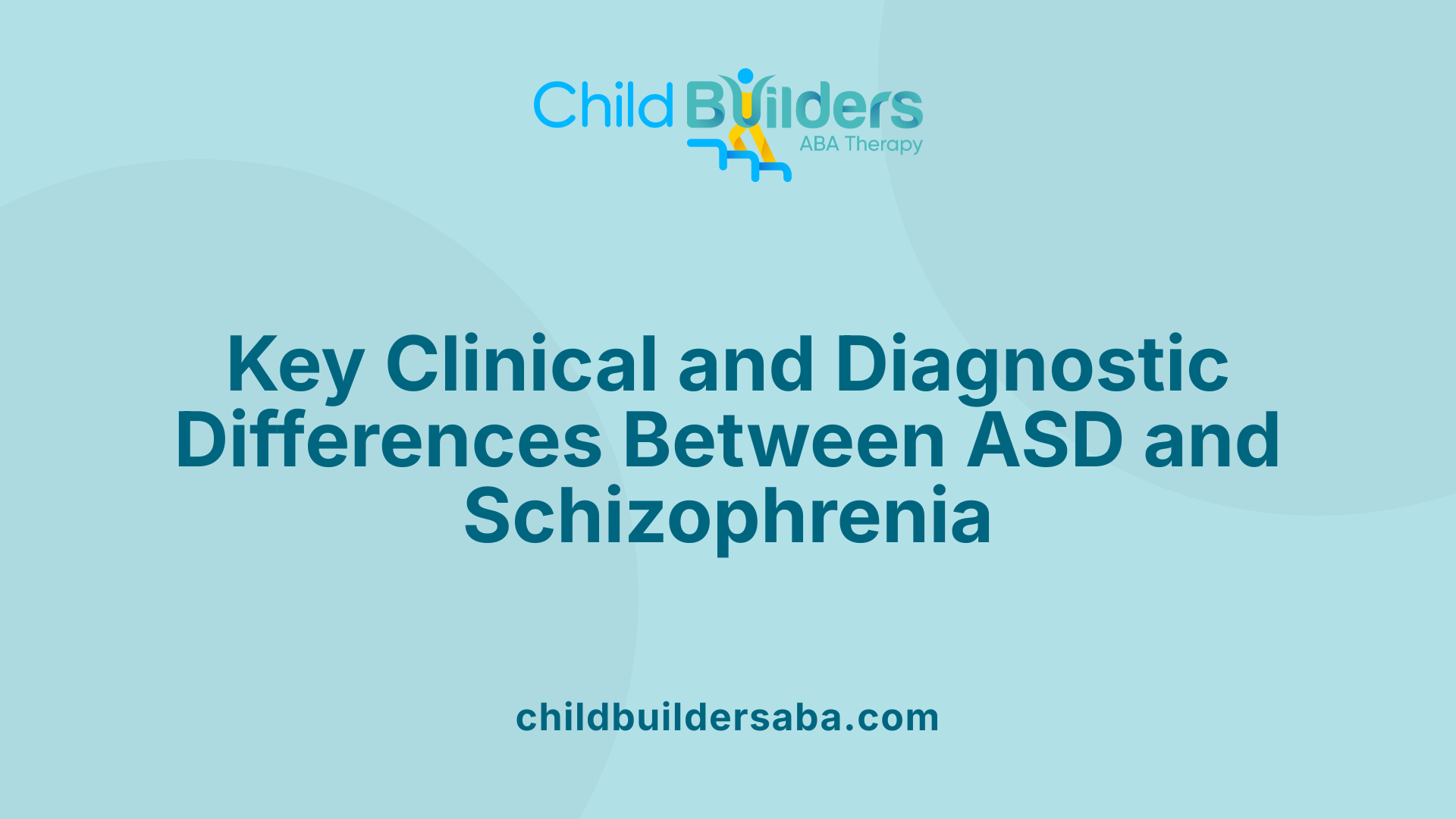
How do the clinical features and diagnostic criteria of autism spectrum disorder and schizophrenia differ?
Autism spectrum disorder (ASD) and schizophrenia (SCZ) are distinct neurodevelopmental and psychiatric conditions with unique diagnostic criteria, but they also share some overlapping features.
Autism typically manifests in early childhood, often diagnosed between 12 to 24 months of age. Its core symptoms include difficulties in social communication and interaction, restricted interests, and repetitive behaviors. Children with ASD may show sensory sensitivities and cognitive rigidity, which influence their perception and behavior. These features tend to have a stable course over time.
In contrast, schizophrenia usually appears during late adolescence or early adulthood. It is mainly characterized by positive symptoms such as hallucinations, delusions, disorganized speech, and disorganized or abnormal motor behavior. Negative symptoms, like social withdrawal, flattened affect, and lack of motivation, are also common. Cognitive impairments, including problems with memory, attention, and reasoning, are often more severe than in ASD.
From a clinical standpoint, ASD involves challenges with implicit understanding of social cues and sensory processing, whereas SCZ entails a perceptual and thought disturbance with a tendency toward delusional thinking and sensory hallucinations.
Despite these differences, some features can overlap, especially social impairments and atypical sensory perceptions. For example, individuals with ASD and those with schizophrenia both exhibit difficulties in social reciprocity and emotion recognition.
Diagnosis hinges on the timing, presentation, and course of symptoms. ASD diagnosis is based on early-onset developmental deficits, while schizophrenia diagnosis requires at least six months of symptoms, including a one-month period of active psychosis.
While the two disorders are separate, research highlights shared neurobiological, genetic, and behavioral markers, which sometimes complicate differential diagnosis. Clinicians rely on detailed assessments of symptom profiles, developmental history, and symptom progression to differentiate ASD from schizophrenia. Accurate diagnosis is crucial, as treatment strategies for each condition differ significantly.
What is the overlap in social cognition deficits?
Both autism spectrum disorder and schizophrenia share significant impairments in social cognition. This includes difficulties in understanding and processing social cues, recognizing emotions, and adopting others’ perspectives, often described as deficits in theory of mind.
Neuroimaging studies reveal similar patterns of neuroanatomical findings in social cognition regions, such as reduced activity in areas involved in facial recognition and emotional processing.
Despite these similarities, the underlying mechanisms differ. In ASD, social cognition deficits often stem from a primary impairment in implicit understanding of social cues and sensory sensitivities. Conversely, in schizophrenia, deficits may result from disrupted neural connectivity and abnormal information processing that affect social perception.
Recognizing these overlapping features is important for clinicians, as targeted interventions can improve social functioning in both conditions. However, the distinction in underlying mechanisms underscores the importance of comprehensive assessment.
Genetic and Neurobiological Underpinnings
What is known about the genetic and neurobiological links between autism and schizophrenia?
Research indicates that autism spectrum disorder (ASD) and schizophrenia (SZ) share significant genetic and neurobiological overlaps. Both conditions exhibit common risk genes, copy number variations (CNVs), and mutations that influence neural development, synaptic function, and chromatin regulation.
Large-scale genetic studies, such as genome-wide association studies (GWAS) and next-generation sequencing, have identified several overlapping risk loci and genes. Notable among these are NRXN1, NLGN4, and SHANK3, which are crucial for synaptic formation and plasticity. These genes highlight shared pathways that affect calcium channel activity, neurotransmitter signaling, and NMDA receptor function, implicating common disruptions in neural connectivity.
Neuroanatomically, both disorders show altered brain structures and connectivity patterns, especially in regions involved in social cognition and emotional regulation. For example, individuals with ASD often demonstrate subtle brain overgrowth and atypical connectivity, whereas schizophrenia is associated with reduced cortical thickness and disrupted brain networks.
Despite their distinct clinical features, the developmental trajectories of both disorders suggest converging neurobiological mechanisms. Shared deficits in synaptic signaling, neural circuit formation, and neurotransmitter imbalances (like GABA and glutamate dysregulation) support the idea that ASD and SZ may exist on a neurodevelopmental spectrum rather than as entirely separate conditions.
Heritability estimates are high for both ASD and SZ, with substantial overlaps in genetic risk factors, indicating a strong genetic component. This overlap suggests that in some individuals, these disorders might reflect different manifestations of shared underlying genetic vulnerabilities.
Understanding these commonalities can pave the way for developing diagnostic biomarkers and tailored treatments that address the shared neurobiological pathways. Moreover, recognizing the continuum of neurodevelopmental disturbances might help in early intervention strategies, potentially modifying disease progression or severity.
Neuroimaging and Brain Development
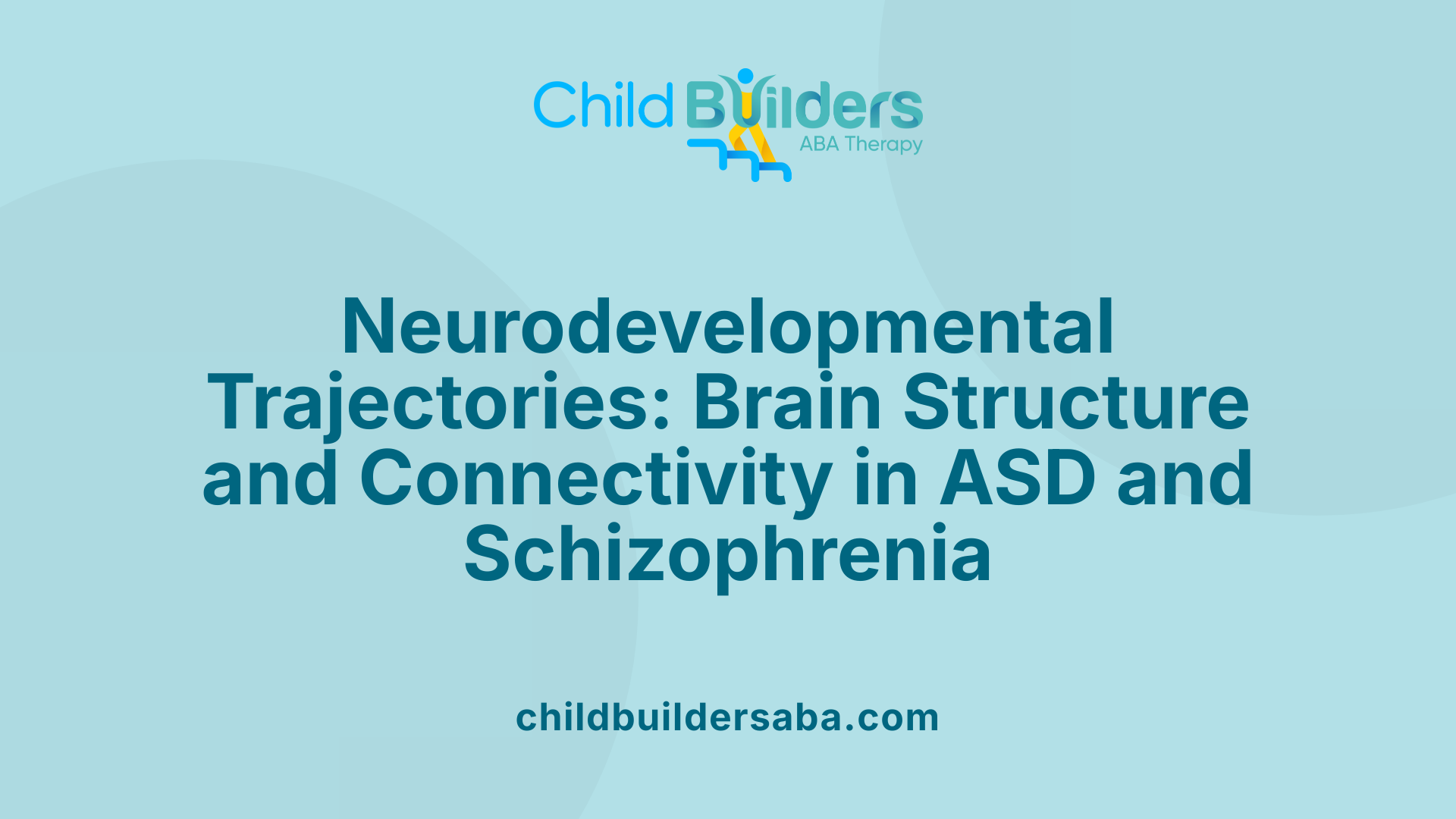
How do brain volume and connectivity patterns differ in ASD and schizophrenia?
Research has revealed notable differences in brain structure and connectivity between autism spectrum disorder (ASD) and schizophrenia (SCZ). In ASD, early neurodevelopmental processes often lead to subtle brain overgrowth, particularly in childhood, resulting in increased total brain volume. Functional imaging indicates that connectivity in ASD tends to be atypical but often involves regions associated with sensory processing and social cognition, with some studies suggesting overconnectivity in certain neural circuits.
Contrastingly, schizophrenia is associated with reductions in cortical thickness, decreased gray matter volume, and widespread disruptions in neural connectivity. Studies show reduced integrity in white matter pathways and decreased connectivity particularly affecting prefrontal and temporal regions, which underpins cognitive deficits and psychotic symptoms.
What are the neuroanatomical similarities and differences?
Both disorders show structural alterations in brain regions involved in social behavior and language, such as the amygdala, hippocampus, and prefrontal cortex. They also share patterns like reduced gray matter volume in specific areas and altered white matter pathways.
However, neuroanatomical differences are distinct: ASD exhibits early brain overgrowth with diffuse cortical enlargement, while SCZ demonstrates cortical thinning and reduced gray matter, especially during adolescence and early adulthood. Connectivity studies suggest that ASD may involve increased local connectivities, whereas SCZ involves disrupted long-range connections.
What implications do these findings have for understanding their pathophysiology?
These neuroimaging insights reveal that although ASD and schizophrenia share some neuroanatomical features, their developmental trajectories diverge significantly. The early overgrowth in ASD suggests a different neurodevelopmental timing, while cortical thinning in SCZ points to neurodegeneration or disrupted pruning during adolescence.
Understanding these differences helps clarify that shared symptoms such as social deficits may arise from distinct neural mechanisms. This knowledge supports tailored interventions targeting specific brain circuits and emphasizes the importance of early diagnosis and neurobiological research to inform more effective treatments.
| Feature | ASD | Schizophrenia | Additional Details |
|---|---|---|---|
| Brain volume | Increased in childhood | Reduced in late adolescence | Overgrowth vs. cortical thinning |
| Connectivity | Atypical, often overconnectivity | Reduced, especially in long-range pathways | Functional implications |
| Structural changes | Diffuse cortical overgrowth | Cortical thinning, gray matter loss | Developmental timing |
| Main neural regions | Sensory, social cognition areas | Prefrontal, temporal cortex | Region-specific effects |
| Clinical relevance | Early diagnosis, neurodevelopment | Progressive cognitive decline | Impacts intervention strategies |
By examining these patterns, researchers gain a clearer picture of how neurodevelopmental and neurodegenerative processes contribute to each disorder's manifestations. The divergence in brain structure trajectories not only aids in accurate diagnosis but also informs targeted therapy approaches aiming to modify neural connectivity and promote optimal developmental outcomes.
Neuroimmune Factors and Cellular Mechanisms
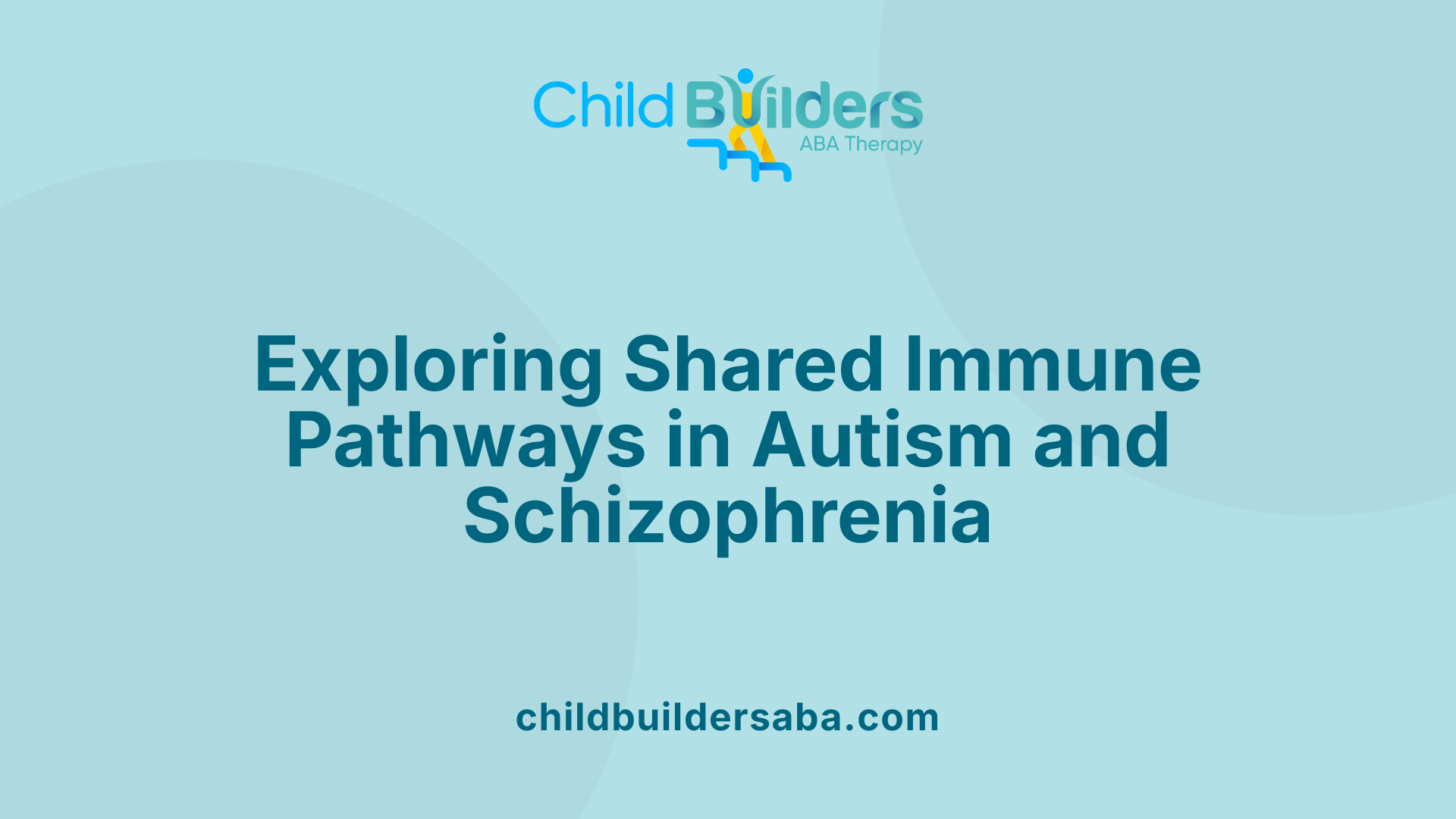
Are there shared neuroimmune factors or cellular mechanisms involved in autism and schizophrenia?
Recent scientific advances reveal that both autism spectrum disorder (ASD) and schizophrenia (SCZ) may share common neuroimmune pathways that influence their development. Evidence suggests that immune activation during critical periods of prenatal development plays a significant role in both disorders.
During pregnancy, maternal immune responses—such as elevated levels of pro-inflammatory cytokines like IL-6, IL-17A, TNF-α, and IL-1β—can impact fetal brain development. These cytokines can cross the placenta or influence the fetal environment, leading to altered neural circuitry formation. For instance, increased maternal cytokine levels have been linked with atypical neural connectivity and increased risk for both ASD and SCZ in offspring.
Microglia, the brain's resident immune cells, are crucial for normal neural development, including synaptic pruning and circuit refinement. However, microglial dysfunction, characterized by either overactivation or inadequate response, has been identified in postmortem brain tissues and neuroimaging studies of individuals with ASD and SCZ. Such dysfunction can cause abnormal synaptic elimination or excess, leading to the neural connectivity disturbances observed in both conditions.
Furthermore, shared cellular pathways involve immune-related genes that regulate inflammatory responses, neural migration, and synaptic plasticity. Variations in genes such as those within the major histocompatibility complex (MHC) and complement system components suggest that immune dysregulation affects neural development and may predispose individuals to either or both disorders.
Environmental factors including maternal infections, autoimmune conditions, and exposure to neurotoxic agents further influence immune activity during development. These factors can trigger epigenetic changes and neuroinflammatory responses, exacerbating underlying vulnerabilities.
Integrating these findings, it becomes clear that neuroimmune mechanisms—especially involving cytokine signaling, microglial regulation, and immune-related genetic pathways—are central to understanding the overlapping pathology of autism and schizophrenia. This convergence highlights potential avenues for targeted interventions aimed at modulating immune responses early in development to mitigate or prevent the manifestation of either disorder.
| Aspect | Mechanism | Impact on Disease Development |
|---|---|---|
| Immune activation | Elevated cytokines during pregnancy | Disrupted neural circuit formation |
| Microglial dysfunction | Abnormal activation or suppression | Altered synaptic pruning and connectivity |
| Genetic factors | Variants in immune-related genes | Increased vulnerability to neurodevelopmental disruptions |
| Environmental influences | Maternal infections, autoimmune diseases | Amplify immune dysregulation and neurodevelopmental risk |
Understanding shared neuroimmune mechanisms in autism and schizophrenia enhances our comprehension of their complex etiology and opens pathways for early diagnosis and therapeutic strategies.
Developmental and Environmental Factors
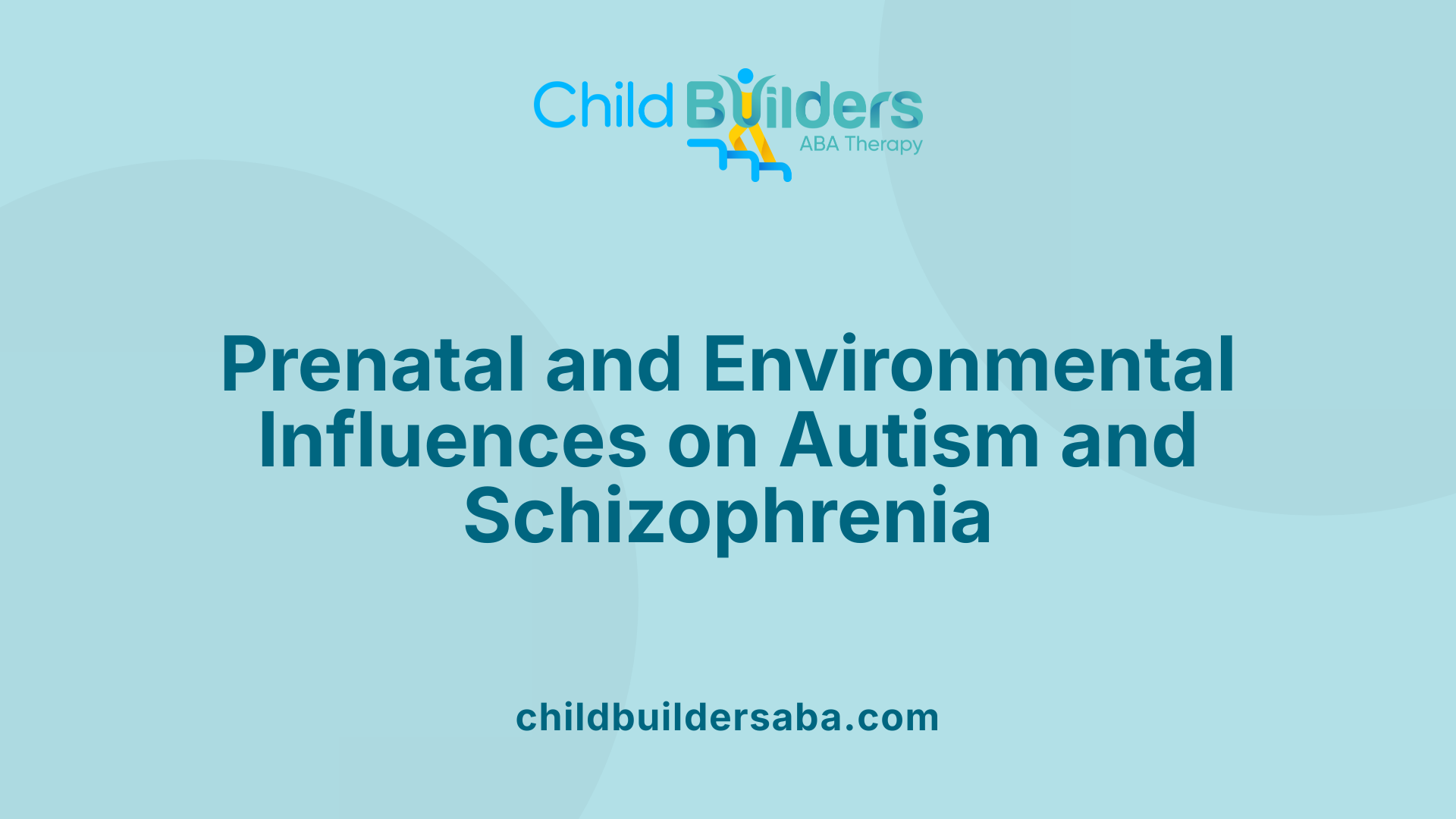
What are the environmental and prenatal factors that contribute to autism and schizophrenia?
Research has shown that early environmental and prenatal influences play a significant role in the development of both autism spectrum disorder (ASD) and schizophrenia (SCZ). One of the most studied factors involves prenatal infection and inflammation. These immune responses during pregnancy can have lasting impacts on brain development in the fetus.
Epidemiologic studies have linked maternal viral infections—such as influenza, rubella, measles, and poliovirus—during pregnancy with an increased risk of schizophrenia in the offspring. Similarly, exposure to bacterial infections and pathogens like cytomegalovirus has been associated with a higher likelihood of autism.
High levels of proinflammatory cytokines, including tumor necrosis factor-alpha (TNF-α) and interleukin-8 (IL-8), measured in maternal blood, are correlated with a greater risk of developing schizophrenia spectrum disorders later in life.
Animal model research supports these observations, demonstrating that prenatal exposure to proinflammatory agents can lead to neural and behavioral abnormalities analogous to those seen in ASD and SCZ. These models suggest that neuroinflammation during critical periods of fetal brain development can cause disruptions in neuronal proliferation, migration, and synaptic formation.
Furthermore, the nature and timing of inflammation appear to influence which disorder develops. Persistent neuroinflammation during fetal development may primarily contribute to autism, characterized by early onset and neurodevelopmental issues. In contrast, latent or long-lasting immune abnormalities might be more relevant to schizophrenia, which often manifests in late adolescence or early adulthood.
Environmental toxins, maternal stress, and nutritional deficiencies also modify neurodevelopmental trajectories, but the impact of infections and immune responses remains a core area of research. Understanding these factors helps in identifying vulnerable populations and developing preventive strategies.
This confluence of genetic predisposition and environmental risk factors, especially prenatal infections, underscores the complexity of autism and schizophrenia etiology. They highlight the importance of maternal health and infection control during pregnancy to reduce the risk of neurodevelopmental disorders.
Comorbidity and Overlap of Symptoms
Is there evidence for comorbidity or overlap of symptoms between autism spectrum disorder and schizophrenia?
Extensive research indicates a notable overlap and co-occurrence between autism spectrum disorder (ASD) and schizophrenia, although they are distinct conditions. Individuals with ASD are three to six times more likely to develop schizophrenia spectrum disorders compared to neurotypical peers. Large population studies have demonstrated a significant association, with reports showing that up to 34.8% of people with autism exhibit psychotic features at some point.
Common symptoms shared between the two include social withdrawal, diminished emotional expression, communication challenges, restricted speech, unusual behaviors, and psychomotor abnormalities. Both conditions also show impairments in social cognition, such as difficulties with theory of mind and emotion recognition. Neuroimaging studies reveal overlapping neurobiological features, including reduced gray matter, altered white matter patterns, and abnormalities in brain regions involved in social interaction and language.
Genetically, several risk loci, including copy number variants like 16p11.2 duplication and 22q11.2 deletion, are implicated in both disorders. Shared pathways may involve dysregulation of neurotransmitters like glutamate and GABA, and common neurodevelopmental disturbances affect brain structures such as the prefrontal cortex.
Operationally, symptoms of psychosis, including hallucinations and delusions, can sometimes occur in individuals with ASD. These symptoms may be difficult to distinguish from typical autistic traits like intense interests or sensory sensitivities, complicating diagnosis. Furthermore, phenotypic overlaps, especially in negative symptoms like social withdrawal, can lead to misdiagnosis.
While the two conditions generally maintain their individual diagnostic criteria, the overlap necessitates careful, nuanced assessment. Recognizing psychosis within ASD, especially in individuals with limited verbal skills, requires clinicians to be vigilant about subtle signs of emerging schizophrenia, emphasizing a multidimensional evaluation approach.
| Aspect | Similarities | Differences | Notes |
|---|---|---|---|
| Symptoms | Social withdrawal, communication deficits, negative symptoms | Hallucinations, delusions (more typical in schizophrenia) | Overlap can mask or mimic each other's features |
| Neurobiology | Brain volume changes, connectivity issues | Specific patterns of cortical overgrowth or reduction | Shared neurodevelopmental disruptions |
| Genetics | Shared risk loci, copy number variants | Variations confer risk for one but not necessarily the other | Different genetic profiles can complicate diagnosis |
| Environmental | Prenatal factors, maternal infections | Timing and effects differ | Shared early developmental impacts |
| Cognitive profile | Impairments in social cognition | Severity and specific deficits vary | Overlapping impairments require differential diagnosis |
Understanding the substantial clinical and biological overlap between ASD and schizophrenia underscores the importance of refined diagnostic tools and personalized treatment approaches. As research progresses, clearer distinctions and shared mechanisms are emerging, guiding better interventions and improving outcomes for affected individuals.
Implications for Treatment and Clinical Practice
What are the treatment options for schizophrenia, and how do they relate to autistic individuals with schizophrenia?
Managing schizophrenia involves a comprehensive approach primarily centered around medication and psychological support. The cornerstone of treatment includes antipsychotic drugs, which help control symptoms such as hallucinations, delusions, and disorganized thinking.
In addition to medication, psychological therapies play a vital role. Cognitive Behavioral Therapy (CBT) is commonly used to help patients challenge and manage distorted thoughts and perceptions. Family therapy can also support the patient’s social environment, improving communication and reducing relapse risk.
Arts and occupational therapies are employed to enhance social skills, emotional regulation, and daily functioning. These approaches are recommended by clinical guidelines like the NICE (National Institute for Health and Care Excellence), which emphasizes tailored treatment plans.
However, managing schizophrenia in individuals with autism presents unique challenges. Since co-occurring autism can influence how symptoms present and how patients respond to treatment, clinicians often adapt their strategies. For example, communication difficulties and sensory sensitivities common in autism require adjustments in therapy settings and methods.
Early diagnosis and personalized intervention are crucial for improving outcomes. For autistic individuals, interventions may include social skills training specifically designed for their needs, along with traditional medical treatments.
Access to mental health services is facilitated through general practitioners, specialized mental health teams, and community organizations like Mind, Rethink Mental Illness, and the NHS. These resources assist in providing ongoing support, reducing distress, and enhancing social integration.
While evidence supports the effectiveness of current treatments for schizophrenia, research continues to explore how best to tailor these approaches for individuals with autism. The goal is to reduce symptoms, improve quality of life, and support full participation in social and occupational roles.
Search query for more information
Treatments for schizophrenia in autistic individuals
Historical and Phenomenological Perspectives
How has the understanding of autism and schizophrenia evolved historically?
Historically, the differentiation and understanding of autism and schizophrenia have undergone significant changes. In 1919, Eugen Bleuler included autism within the broader diagnosis of dementia praecox, which was an early term for schizophrenia. This reflected a view that autism was a manifestation or symptom of schizophrenia, emphasizing a close clinical relationship.
By 1952, when the DSM was published, autism was still considered an expression of childhood schizophrenia. It was thought to be part of the same spectrum, with overlapping features that blurred clinical boundaries.
However, over the subsequent decades, increased research and clinical observations led to a reevaluation. In the 1980 DSM, autism was recognized as a distinct developmental disorder, separate from schizophrenia, based on differences in onset, symptomatology, and developmental course.
Modern understanding now appreciates that, although autism and schizophrenia are separate conditions, they share some overlapping features and underlying biological mechanisms. Advances in neuroimaging, genetics, and neuropsychology have helped clarify these relationships, highlighting both the profound differences and notable overlap in certain symptoms and biological markers.
Phenomenology of Social and Self-Experiences
What is known about the phenomenological and self-experiential differences between autism and schizophrenia?
Schizophrenia is often understood as a disorder fundamentally affecting the minimal self, often called ipseity. People with schizophrenia experience impairments in pre-reflective self-awareness, leading to feelings of disembodiment and a fragmented self-narrative. This results in a diminished sense of self, making it difficult to construct a coherent identity over time. Patients often report disturbances in the perception of their own thoughts and actions, struggle with reality testing, and may feel as if their thoughts or experiences are not truly their own. Neurobiologically, these experiences are linked to disruptions in temporal integration, autobiographical memory, and a sense of ownership over one’s body and perceptions.
In contrast, autism spectrum disorder primarily impacts the interpersonal or social self. Individuals with ASD typically have challenges with understanding social cues, recognizing others’ emotions, and engaging in social-emotional interactions. Their difficulties are more centered on the implicit, embodied aspects of social cognition, such as resonance with others’ emotions and intuitive social understanding. Importantly, ASD generally does not involve a fundamental disturbance of the minimal self or a core self-estrangement. Their sense of identity and conscious self-awareness remain relatively stable, but their social understanding is impaired at a more implicit, pre-reflective level.
The phenomenology of these disorders reflects these distinctions. In schizophrenia, experiences often include a fractured or unstable sense of self and reality, with symptoms like delusions and hallucinations highlighting a disrupted perception of the world and oneself. Meanwhile, in autism, social and self-experiences are characterized by deficits in the embodied, automatic understanding of others’ emotions and intentions. This leads to difficulties in social reciprocity and empathic engagement, but not a disruption of the core perceptual or existential sense of self.
Understanding these phenomenological differences is crucial for clinicians, as it helps differentiate between conditions that might superficially appear similar in social behaviors but vary significantly in their underlying consciousness and self-experience. As research progresses, a more detailed account of how self-awareness and social cognition are uniquely affected in autism and schizophrenia continues to develop, shedding light on the complex fabric of human self-experience.
Bridging the Gaps in Understanding Autism and Schizophrenia
The relationship between autism and schizophrenia is complex, multifaceted, and rooted in shared neurodevelopmental and genetic pathways. While they are distinct diagnoses with different onset periods and symptom profiles, overlapping features, shared genetic markers, and converging neurobiological mechanisms highlight the necessity for continued research. Improving diagnostic accuracy, understanding their common and divergent pathways, and developing tailored interventions are essential steps toward better management and support for individuals affected by these conditions. Recognizing the neuroimmune functions and cellular mechanisms involved might pave the way for novel therapeutic approaches, ultimately bridging the gaps in our understanding and treatment of these complex disorders.
References
- Autism spectrum disorder and schizophrenia - PubMed Central
- Autism and Schizophrenia: Is There a Link? - Healthline
- Schizophrenia - a guide for autistic adults
- Autism spectrum disorder and schizophrenia: a phenomenological ...
- Can you have autism and schizophrenia at the same time?
- Autism Spectrum Disorders and Schizophrenia Spectrum Disorders
- The co-occurrence of autistic spectrum disorder and schizophrenia
- Autism, ADHD, and Schizophrenia in Children and Adolescents



.jpg)

































































































